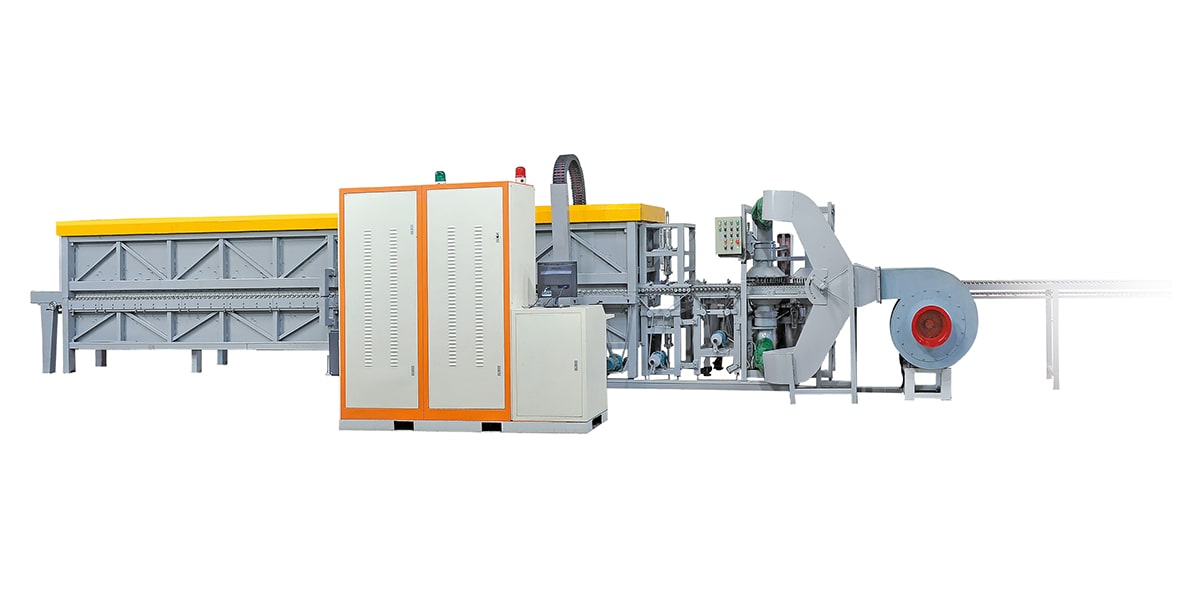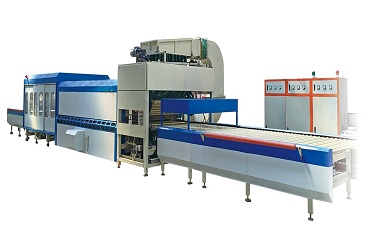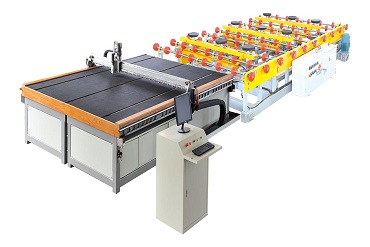You Need To Know The Tempered Glass Furnace !
- By:LiaoDA
- Date:2022-09-20
Whether it is a large glass display case or a glass cell phone screen, tempered glass furnace is a common material to protect products and personnel. Therefore, the quenching process is very important. The tempering furnace uses heat to strengthen and prepare glass for various applications. There are a variety of tempering furnaces, depending on the type of glass and the capacity, volume and size of the manufacturing company.
What Is A Tempering Furnace ?
A tempering furnace is an industrial furnace designed to heat treat ferrous metal products and increase their toughness. In metallurgical terms, the toughness of an alloy describes its ability to elastically deform and absorb energy before the material fractures. This is part of the complex relationship between ductility and strength in metals, and high toughness values require a subtle intersection of the two. Typically, high-strength materials are not ductile – and vice versa – but heat treating certain materials in a tempering furnace can release beneficial value on both axes of this mechanodynamics.
In order to temper the glass, the tempering furnace heats the glass to an extremely high temperature, usually above 600 degrees Celsius. Then, using air jets, the furnace cools the glass evenly and quickly. The rapid cooling process is called quenching. During the tempering process, the glass undergoes extreme compression and gains resistance to impact and thermal shock.
The heating and cooling processes that occur during the tempering process increase the strength of the glass and reduce the risk of cracking or shattering. However, if the tempered glass does break, it will shatter into several small pieces with spherical edges instead of large, sharp pieces. This reduces the risk of serious injury.
Tempering is a process that dates back thousands of years, and the theory behind it has remained relatively unchanged over the centuries since. It is the process of achieving the highest intersection of strength and elasticity of iron-containing or iron-based metal products through a limited degree of heat treatment, usually after a quenching process. Modern tempering processes may theoretically be similar to ancient processes, but the equipment used today is vastly improved. For example, quenching, which once required a homogeneous liquid (such as mercury) to properly precipitate the hardening of ferrous alloys, can now be performed using vacuum or airflow techniques. The tempering furnace also has the new function of "softening" the ferrous metal after the product has been quenched.
Tempering furnaces use ceramic heating elements lined with wires or coils to evenly heat the sample chamber to different heating ranges depending on the material properties required for the product. Iron-based metals are heated between 300 and 750°C (572 and 1382°F) in a tempering furnace to promote phase transformation within the martensitic structure and reduce the hardness of the material while increasing its ductility. Basically, the quenching furnace can accurately maintain temperature levels and temperature uniformity throughout the sample chamber to eliminate the possibility of metal warping or fracture.
What Is Tempered Glass Furnace Machine ?
Tempered glass furnace machine is a safer product than other types of glass, it is hardened or strengthened by a controlled heat treatment process. Therefore, sometimes you can hear tempered glass called safety glass or tempered glass. The glass treated by the tempering furnace is not only stronger and safer, but also easier to bend.
Some common applications of tempered glass include ovens, coffee machines, computer and phone screens, and shower windows and doors, to name a few. Iron-based metal products are uniformly heated to temperatures up to 1650°F (900°C) and then immersed in a liquid bath or air oven. Typically the material will be allowed to soak in the quenching environment for several minutes to promote the formation of high strength martensite in the material before quenching it in the liquid material. Once the product has cooled, it is transferred to a tempering furnace to reduce its strength and brittleness to the desired level.Why Use Auto Glass Tempering Furnace ?
Auto glass tempering furnace has more advantages than standard glass. Glass tempering furnace and tempering process make tempered glass stronger and safer than standard glass. This reduces the risk of glass breakage, or if the glass does break, also reduces the risk of injury. Broken tempered glass is easier to clean than standard broken glass. Besides being safer and stronger, tempered glass has also been found to be more resistant to scratches, damage and heat. Due to its higher tensile strength, tempered glass is considered bulletproof and stormproof, making it ideal for applications such as storefront systems or doors and windows. commercial and residential.
Crafts of Tempered Glass Furnace Machines
A tempered glass furnace machine is a device that melts glass and produces a tempered glass product. The temperature of the tempered glass can be adjusted by a software that controls the blower motor speed. The top unit of the machine is designed to be elevated to avoid any breakages. The nozzle on the cooling unit is automatically positioned according to the thickness of the glass. There are various kinds of tempered glasses. There are different types of tempered glass furnaces. The tempered furnace machines are also known as a tempering machine. T-Series is best for large-scale production. It has a high air pressure and a high temperature control system. This model has an adjustable heating nozzle. It has an aramid fiber iron frame. The blower is controlled by an electrical system, which makes it easy to temper the glass.
A tempered glass furnace machine has a programmable thermostat for temperature adjustment. The temperature of the glass furnace can be adjusted in increments of 1 degree celsius. The furnaces are designed to heat and cool the glass in a uniform manner. The tempered glass is generally cooled with air flow. If the tempered material is too hot for the user, the alarm will go off. If the temperature goes too high, the machine will automatically cut off the power. Tempered glass furnace machines are also commonly referred to as tempering machine. The temperature of the tempered glass is cooled rapidly with forced air drafts. The inner part of the glass is left open to the air, and this is the characteristic that makes the tempered glass tough and strong. It meets the minimum fire resistance standards of E30 and Fox. The tempered glass is produced in this way. This process is called thermal tempering.
The tempered glass is produced using a tempering process. The tempered glass is the finished product. In addition to the rigid body of the tempered annealing chamber, the furnaces are equipped with high-grade insulating material. The melted glass is then transferred to the quenching chamber. The resulting tempered glass is characterized by a smooth surface. In fact, the temperature can be easily changed from one degree to another through a control system. The tempered glass is produced using a tempered glass furnace machine. The annealed glass is then cooled to a tempering temperature. The cooled glass is a result of this process. The annealed glass is a result of this process. It is often the case that the tempered and fused glass is made with a spherical shape. In addition, it is often asymmetrical. This is the reason why the TEMPERING Furnace is so important.
The Function of Glass Chemical Tempering Furnace
LiaoDa's glass chemical tempering furnace (GCTF) is a type of industrial furnace designed to work with a variety of materials and processes. The process uses a combination of heat and chemicals to change the physical properties of glass. While the process is known as thermal tempering, there are also certain aspects of this process that are not so easily understood. If you're considering purchasing one of these furnaces, be sure to read through this article before making the decision. Besides, it can be customized to suit your production needs and your factory layout. These furnaces can provide excellent flatness and transparency to the glass. The blower and collector group are controlled by a driver that adjusts the speed and pressure of the furnace.
The temperature, moisture, and concentration of SO₂ all affect the formation of sodium vapours. Proper ventilation and roller seals are necessary for controlling dust in the furnace. The thermal gradient and atmosphere distribution of the furnace are also essential for achieving a stable environment for the formation of Na2SO4 . The presence of SO₂ in the glass chemical tempering furnace provides the final touch of contact for the glass, forming a sodium sulphate interlayer. At high temperatures, reactivity is achieved by the formation of different sulphates. However, it is harder to obtain these reactivity levels inside glass, due to the stability of ionic species.

Another important difference between liquid and gas-based tempering is the specific heat of water. Liquids have high specific heats and their vaporization is much higher. The specific heat of water is much larger than that of air, so the water mist will rapidly absorb the heat and turn to liquid. The high heat of vaporization of water also removes a large portion of heat from a glass surface. Furthermore, it increases the tensile strength of glass. Chemical glass strengthening makes the glass stronger by promoting ion exchange in its surface layers, while encouraging tension in its inner layers. The resulting tension strengthens the glass and prevents it from breaking or cracking. The process can be used on even the thinnest glass without warping the surface. As a result, it is an excellent option for windows and optical products. The benefits of this treatment go far beyond the aesthetics of a piece of glass.
Maybe You Need A Tempered Glass Cutting Machine
Tempered glass cutting machine is an ideal tool for making glassware which allows you to cut tempered glass with ease. The machine weighs about three thousand kilograms and is capable of processing a variety of different sizes and shapes. The cutter can be set to either cut a thin piece of glass or a thick one. Its adjustable pressure and distance can help you achieve a perfect finish for your products. It can also cut thicker pieces of tempered or toughened tempered glasses. When using this machine, you should mark the dimensions to make sure that the glass cuts properly. It is also best to use a dowel underneath the marking to apply moderate pressure to the glass surface. The cutting blade should be sharp so that the edges are not blurred. Once the tempered glass is cut, you can remove it from its backing sheet easily. However, if you need to cut several pieces, you can use the same blade.
This kind of tempered glass cutting machine is designed for 0.2-4.0 mm float glass and special glass. The Y axis is equipped with a double screw guide that minimizes noise and ensures accurate cutting. The cutter is suitable for both smooth and rough glass surfaces. The curved edges of a tempered glass cutting machine are a feature that makes it ideal for use in architectural decoration and precision electronics. The glass cutter comes with an automatic cooling system and an advanced laser module. Liaoda's tempered glass cutting machine is used to cut special types of glass and float glass. It is compatible with 0.2-4.0 mm float and special glass and can also be used in the architectural decoration and precision electronics industries. It has an integrated mill/CAD/NC software and a dual-screw guide for a smooth and quiet cutting process. If you are a beginner in glass cutting, you can learn the basic techniques by observing the video tutorials online.
From other aspects, Its versatility makes it a perfect choice for the production of tempered glass and other materials. Liaoda glass tempering machine is a great investment for any industry. When used properly, it will save you time and money. There are a few things to keep in mind before buying a tempered window cutting machine. It will be able to cut the glass perfectly no matter what size it is. A tempered panel is an extremely durable, insulated panel that can last a long time.
-
WhatsApp
CONTACT US

LIAODA (LAD) Glass Machinery Co., Ltd.
We are always providing our customers with reliable products and considerate services.
If you would like to keep touch with us directly, please go to contact us






